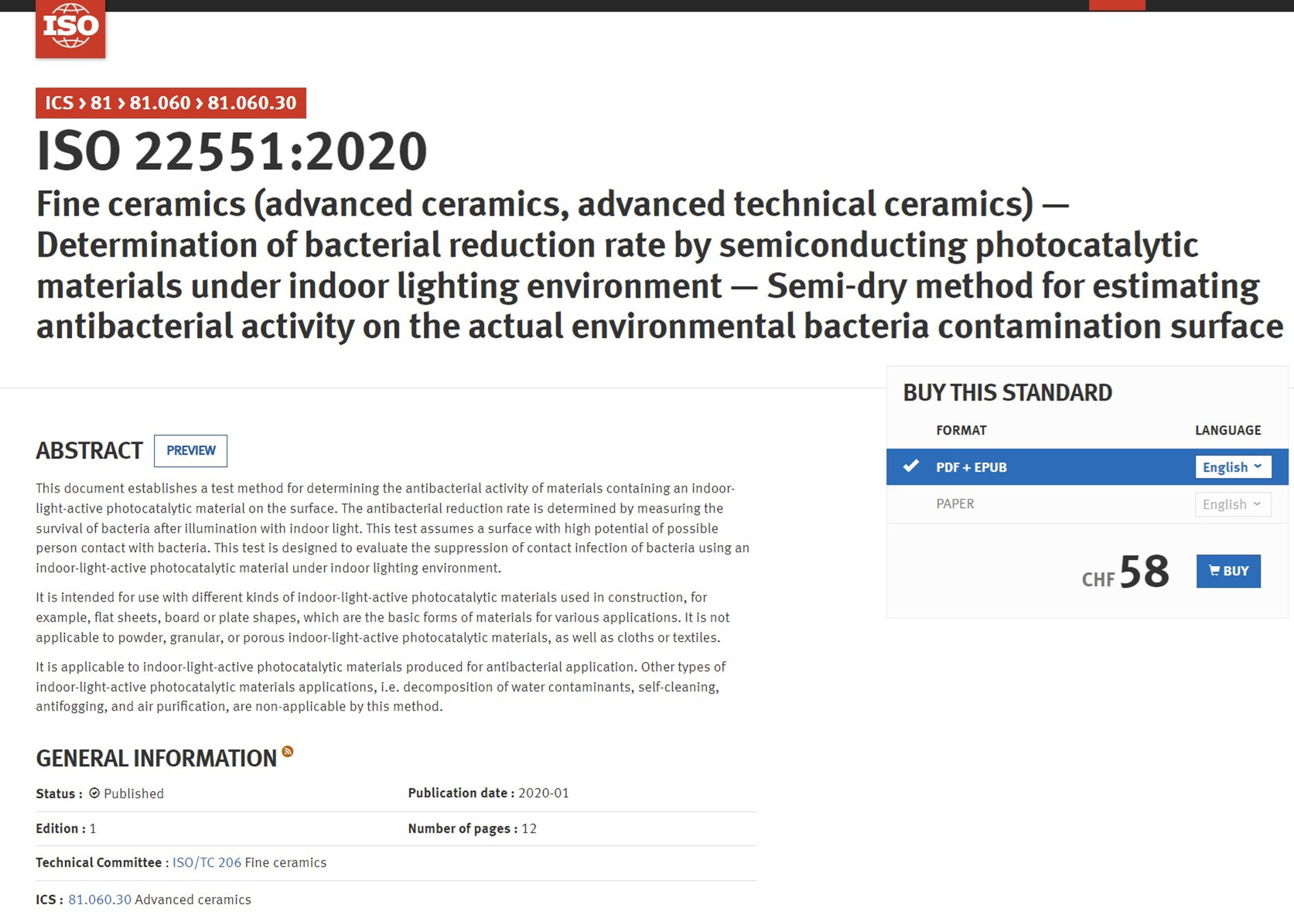精细陶瓷(高级陶瓷、高级工业陶瓷) 室内照明环境下半导体光催化材料对细菌还原率的测定 在实际环境细菌污染表面上估计抗菌活性的半干法
时间:2022-03-07 16:31:53 来源:ISO 点击量:

ISO 22551:2020
Fine ceramics (advanced ceramics, advanced technical ceramics) — Determination of bacterial reduction rate by semiconducting photocatalytic materials under indoor lighting environment — Semi-dry method for estimating antibacterial activity on the actual environmental bacteria contamination surface
Introduction
This document applies to testing the antibacterial activity of indoor-light-active photocatalytic ceramics and other materials, produced by either coating or mixing of a light-active photocatalyst in a simulated indoor lighting environment. The International Standard for testing the antibacterial activity of photocatalytic materials has been published as ISO 27447 and the International Standard for testing the antibacterial activity of indoor-light-active photocatalytic materials has been published as ISO 17094.
Recently, it was discovered that antibacterial activities by indoor-light-active photocatalyst showed different results between the ISO 17094 testing in a laboratory and the evaluation in a real environment. Thus, the ISO 17094 testing method should be complemented by a testing method that simulates an indoor lighting environment.
ISO 17094 is one of the best methods for measuring the potential of antibacterial activity using photocatalysts. This document can measure the reduction rate of living bacteria by testing with impure substances similar to an indoor lighting environment.
WARNING Handling and manipulation of microorganisms that are potentially hazardous requires a high degree of technical competence. Only personnel trained in microbiological techniques should carry out tests.
1 Scope
This document establishes a test method for determining the antibacterial activity of materials containing an indoor-light-active photocatalytic material on the surface. The antibacterial reduction rate is determined by measuring the survival of bacteria after illumination with indoor light. This test assumes a surface with high potential of possible person contact with bacteria. This test is designed to evaluate the suppression of contact infection of bacteria using an indoor-light-active photocatalytic material under indoor lighting environment.
It is intended for use with different kinds of indoor-light-active photocatalytic materials used in construction, for example, flat sheets, board or plate shapes, which are the basic forms of materials for various applications. It is not applicable to powder, granular, or porous indoor-light-active photocatalytic materials, as well as cloths or textiles.
It is applicable to indoor-light-active photocatalytic materials produced for antibacterial application. Other types of indoor-light-active photocatalytic materials applications, i.e. decomposition of water contaminants, self-cleaning, antifogging, and air purification, are non-applicable by this method.
2 Normative references
The following documents are referred to in the text in such a way that some or all of their content constitutes requirements of this document. For dated references, only the edition cited applies. For undated references, the latest edition of the referenced document (including any amendments) applies.
ISO 14605, Fine ceramics (advanced ceramics, advanced technical ceramics) — Light source for testing semiconducting photocatalytic materials used under indoor lighting environment
ISO 17094:2014, Fine ceramics (advanced ceramics, advanced technical ceramics) — Test method for antibacterial activity of semiconducting photocatalytic materials under indoor lighting environment
3 Terms and definitions
For the purposes of this document, the following terms and definitions apply.
ISO and IEC maintain terminological databases for use in standardization at the following addresses:
— ISO Online browsing platform: available at https://www.iso.org/obp
— IEC Electropedia: available at http://www.electropedia.org/
3.1
photocatalyst
substance that performs one or more functions based on oxidization and reduction reactions under photoirradiation, including decomposition and removal of air and water contaminants, deodorization, antibacterial, antifungal, self-cleaning and antifogging actions
3.2
indoor-light-active photocatalyst
photocatalyst (3.1) that functions under illumination with artificial light used for general lighting purposes
3.3
indoor lighting environment
illumination with artificial light source(s) used for general lighting purposes and excluding sunlight
3.4
indoor-light-active photocatalytic material
material in which or on which the indoor-light-active photocatalyst (3.2) is added by, for example, coating, impregnation or mixing
3.5
reduction rate of living bacteria
reduction of the viable bacteria counts on the surface of indoor-light-active photocatalytic materials (3.4) versus that of non-treated materials after treatment under illumination or in a dark condition for a designated time, expressed as a proportion of the bacteria in percentage per unit of inoculating mass
3.6
dispersion medium
medium used for the preparation of a test bacterial solution, comprising a chemical component, which simulates human sebum
CIAA会员单位免费下载
